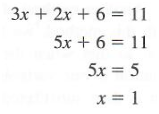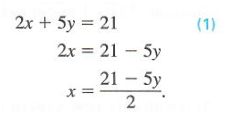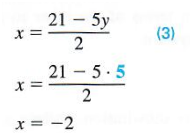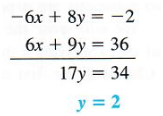Solving a system of two linear equations
Solving a system of linear equations by substitution
Example 1
The substitution method involves substituting an expression for one variable in terms of the other in another equation of a system. For example, to solve the system

by substitution, replace y in the first equation

noticing that parentheses are required. Then solve this equation for x.

Replace x with 1 in y = x + 3 to find that y = 1 + 3 = 4. The solution set for this system is {(1, 4)}.
Example 2:
Solve the system

Begin by solving one equation for one of the variables in terms of the other. For example, solving the first equation for x gives :

Now substitute this result for x into equation (2).

To eliminate the fraction on the left, multiply both sides of the equation by 2 and then solve for y.

Substitute y = 5 back into equation (3) to find x

The solution set for the system is ((-2, 5)}. Check by substituting -2 for x and 5 for y in each of the equations of the system.
Solving a system of linear equations by addition
Another method of solving systems of two equations is the addition method. With this method, we first multiply the equations on both sides by suitable numbers, so that when they are added, one variable is eliminated. The result is an equation in one variable that can be solved by methods used for linear equations. The solution is then substituted into one of the original equations, making it possible to solve for the other variable. In this process the given system is replaced by new systems that have the same solution set as the original system. Systems that have the same solution set are called equivalent systems. The addition method is illustrated by the following examples.
Solve the system

eliminate x, multiply both sides of equation (4) by -2 and both sides of equation (S) by 3 to get equations (6) and (7).

Although this new system is not the same as the given system, it will have the same solution set.
Now add the two equations to eliminate x, and then solve the result for y.

Substitute 2 for yin equation (4) or (5). Choosing equation (4) gives

The solution set of the given system is { (3, 2)}, which can be checked by substituting 3 for x and 2 for y in equation (5).
Since the addition method of solution results in the elimination of one variable from the system, it is also called the elimination method.